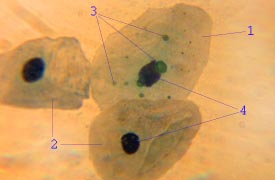Chlamydia pneumoniae
| name = Chlamydia pneumoniae | picture = Chlamydia pneumoniae.jpg | title = Chlamidia pneumoniae | family = Chlamydiaceae | Occurence = human intracellular parasite | Disease = nosocomial pneumonia, atypical pneumonia, endocarditis, myocarditis, infectious or reactive artritis | Infectious stage and method of infection = interpersonal contact | diagnostics = detection of IgM and IgG specific against elementary bodies by microimmunofluorescence reaction | therapy = doxycyline, azithromycin, clarithromycin, symptomatic treatment | MeSH ID = }}
Chlamydia pneumoniae is a species of intracellular bacterium of the genus Chlamydia and the family Chlamydiaceae. This division is traditional and still widely used, but Chlamydia pneumoniae, together with Chlamydia psittaci, has been reclassified into the genus Chlamydophila. It is an intracellular energy parasite, because chlamydia do not have their own ATP production system and uses ATP host cells. Chlamydia pneumoniae is an exclusively human pathogen, of all the types of chlamydia being the most widespread in the population.
Inclusion[edit | edit source]
Chlamydia pneumoniae was classified as a separate species when it was found to have less than 10% DNA homology with the other two chlamydia species. Formerly known as TWAR strain Chlamydia trachomatis. In the microscope, we can recognize it by pear-shaped inclusions with a wide periplasmic space.
The causative agent of the disease[edit | edit source]
Infections caused by Chlamydia pneumoniae are very rare in children aged 1-5 years. In adults, the cause is about 5% of primary sinusitis, 4% of bronchitis, 10% of nosocomial pneumonias and upper respiratory tract inflammation.[1] Its action probably also applies to endocarditis and myocarditis. Infectious or reactive arthritis can be a complication of the infection . Like Mycoplasma pneumoniae, Chlamydia psittaci, Legionella pneumophilla and Coxiella burnetii , Chlamydia pneumoniae is a causative agent of atypical pneumonias.
Diagnostics[edit | edit source]
Chlamydia pneumoniae infection does not produce enough antibodies, so recurrent infections are possible. However, the immune response of the host is used in serological diagnosis. The antigen with which KFR reacts is gender specific, so it is not possible to identify the species. This can be determined on the basis of specific antibodies against the elementary bodies of Chlamydia pneumoniae, which we demonstrate by a microimmunofluorescence reaction, namely IgM and IgG.
Therapy[edit | edit source]
Infections caused by this pathogen are routinely treated with antibiotics. Doxycycline or azithromycin are currently the drugs of choice for adults, and clarithromycin or azithromycin for children. Recently, however, research has shown that antibiotics often do not have the right effects, do not improve health or speed up recovery. Therefore, some experts in immunocompetent individuals without a serious underlying non-infectious disease only recommend the administration of symptomatic medications, adequate fluid intake, and bed rest.
Links[edit | edit source]
Related sources[edit | edit source]
Reference[edit | edit source]
- ↑ BEDNÁŘ, Marek, et al. Medical microbiology : Bacteriology, virology, parasitology. 1. edition. Praha : Marvil, 1996. 330 pp. ISBN 80-238-0297-6.
References[edit | edit source]
- BEDNÁŘ, Marek – SOUČEK, Andrej – FRAŇKOVÁ, Věra, et al. Medical microbiology : Bacteriology, virology, parasitology. 1. edition. Praha : Marvil, 1996. 558 pp. ISBN 8023802976.
- GOERING, Richard V. – DOCKRELL, Hazel M.. Mims' medical microbiology. 5. edition. Praha : Triton, 2016. 568 pp. ISBN 978-80-7387-928-0.
- Z. KARIMOVA, – V. PETRŮJOVÁ, – H ROHÁČOVÁ,. Chlamydia pneumoniae and Mycoplasma pneumoniae in the etiology of respiratory infections - early diagnosis and adequate treatment. Post-graduate medicine. 2016, y. 1, p. 28-31, ISSN 1212- 9445.

